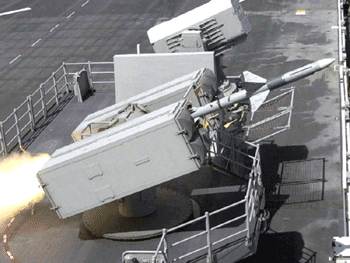 Services: Navy, Marine Corps, and Air Force
Services: Navy, Marine Corps, and Air Force

Last updated: 8 August 2003
 Services: Navy, Marine Corps, and Air Force
Services: Navy, Marine Corps, and Air Force
Description: A highly maneuverable air-to-air missile with surface-to-air capability.
Features: The Navy's RIM-7M Sea Sparrow surface-to-air missile and the Navy, Marine Corps, and Air Force's AIM-7 Sparrow air-to-air missile are radar-guided missiles with high explosive warheads. They have a cylindrical body with four wings at mid-body and four tail fins. The Navy uses the Sea Sparrow version aboard ships as a surface-to-air anti-missile defense.
The versatile Sparrow has all-weather, all-altitude operational capability and can attack high-performance aircraft and missiles from any direction. It is widely deployed by U.S., NATO and other FMS forces. The Sea Sparrow is found aboard many U.S., NATO, and other FMS surface warships.
Background: Originally developed as an air-to-air missile by Sperry and the U.S. Navy, Sparrow's later versions were developed and produced by Raytheon Company, General Dynamics, and Hughes Missile Systems. Subsequent versions were dubbed the "dog-fight modification" because its increased maneuverability at short range made it better suited for close-in visual engagements. The surface-to-air capability was then added to provide point defense capability for surface combatants. It is utilized in the Trainable Launch configuration by the Navy and in both the Trainable Launch and Vertical Launch configurations by NATO and other FMS customers.
The first production Evolved Sea Sparrow Missile (ESSM), an international cooperative upgrade of the RIM-7 NATO Sea Sparrow missile, was delivered in late 2002 to the U.S. Navy by Raytheon. The new missile provides the primary air defense for capital ships of the 10 participating NATO navies. The program is managed by the NATO Sea Sparrow Consortium, a 32-year-old organization described as NATO’s largest and most successful cooperative weapons project.
ESSM has the speed, agility and accuracy to engage threats at maximum range
and under the most challenging conditions.
The final phase of the missile’s flight test program is scheduled for
early spring 2003, when performance with the Aegis Fire Control System
of the U.S. Navy’s Arleigh Burke-class guided missile destroyers
will be verified.
Points of Contact:
Navy:
Naval Air Systems Command
PEO-T Public Affairs Officer
47123 Buse Road, Bldg 2272, Rm 454
Patuxent River, MD 20670-1547
(301) 481-6263
Marine Corps:
Headquarters, U.S. Marine Corps
Public Affairs Division
Washington, DC 20380-1775
(703) 614-1492
Air Force:
Air Combat Command
Public Affairs Office
115 Thompson St., Suite 211
Langley AFB, VA 23665-2191
(757) 764-5014
General Characteristics
Primary Function: Air-to-air and surface-to-air radar-guided
missile
Contractors: Raytheon Co., General Dynamics, and Hughes Missile
Systems
Power Plant: Alliant TechSystems (Hercules) MK-58 solid-propellant
rocket motor
Thrust: Classified
Speed: Classified
Range: Classified
Length: 12 feet (3.64 meters)
Diameter: 8 inches (20.3 cm)
Wingspan: 3 feet 4 inches (one meter)
Warhead: Annular blast fragmentation warhead, 90 pounds (40.5
kg)
Launch Weight: Approximately 500 pounds (225 kg)
Guidance System: Raytheon semi-active on continuous wave or
pulsed Doppler radar energy
Date Deployed: 1976
Unit Cost: $165,400
Inventory: Classified
Aircraft Platforms:
Navy: F-14 and F/A-18;
Air Force: F-4, F-15, and F-16;
Marine Corps: F-4 and F/A-18
Surface Platforms:
CVs, LHAs,
DD-963s, AOEs
 Return to the Fact File Table of contents.
Return to the Fact File Table of contents.